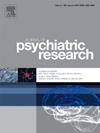Effects of high-definition transcranial direct current stimulation on drug craving in patients with methamphetamine use disorder
IF 3.7
2区 医学
Q1 PSYCHIATRY
引用次数: 0
Abstract
Background
High-definition transcranial direct current stimulation (HD-tDCS) has been used as a non-invasive brain stimulation technique in drug-addicted populations. The current study found that HD-tDCS may reduce drug craving in methamphetamine (MA) addicts by stimulating the left and right sides of the dorsolateral prefrontal cortex (DLPFC) in the brain.
Methods
In this study, 60 patients with MA use disorder were recruited and randomly assigned to three groups: the left DLPFC group, the right DLPFC group, and the sham stimulation group, the groups received a 20-min HD-tDCS intervention for 8 consecutive days. The stimulation intensity was set at 1.5 mA, but in the sham stimulation group, the current increased to 1.5 mA within 30 s of the start of the intervention, and then rapidly decreased to 0 to cause the stimulation sensation. All groups completed tests related to physiological, explicit and implicit drug craving during the pre and post-testing phases, and were followed up after 1 month.
Results
(a) compared with the pre-test data, the left and right DLPFC groups at the post-test stage showed significant decreases in heart rate values, explicit and implicit drug craving scores, while the sham stimulation group showed no significant differences; (b) the intervention effects on drug craving scores were compared between the left and right DLPFC groups found no significant differences; (c) one-month follow-up test found that compared with the pre-test, the left and right DLPFC groups follow-up test explicit craving scores were significantly lower compared to the pre-test, but significantly higher compared to the post-test; also implicit drug craving scores were not significantly different compared to the pre-test, but increased compared to the post-test.
Conclusion
These results suggest that eight consecutive sessions of HD-tDCS may be effective in reducing immediate drug craving in patients with MA use disorder, but whether the effects of the intervention are sustained needs to be confirmed by further research.
高清晰度经颅直流电刺激对甲基苯丙胺使用障碍患者药物渴求的影响
高清晰度经颅直流电刺激(HD-tDCS)作为一种非侵入性脑刺激技术已被应用于吸毒成瘾人群。目前的研究发现,HD-tDCS可以通过刺激大脑背外侧前额叶皮层(DLPFC)的左右两侧来减少甲基苯丙胺(MA)成瘾者的药物渴望。方法本研究招募60例MA使用障碍患者,随机分为左DLPFC组、右DLPFC组和假刺激组,每组接受20 min HD-tDCS干预,连续8 d。刺激强度设定为1.5 mA,但假刺激组在干预开始后30秒内电流升至1.5 mA,然后迅速降至0,产生刺激感觉。各组在测试前后均完成生理、外显和内隐药物渴望相关测试,1个月后进行随访。结果(a)与测试前数据相比,左、右DLPFC组在测试后心率值、外显和内隐药物渴望得分均显著降低,而假刺激组无显著差异;(b)左、右DLPFC组对药物渴望评分的干预效果比较,无显著差异;(c) 1个月随访测试发现,左、右两组DLPFC随访测试外显渴望得分显著低于前测,但显著高于后测;内隐药物渴望得分与前测相比差异不显著,但与后测相比有所增加。结论连续8次HD-tDCS可有效降低MA使用障碍患者的即时药物渴望,但干预效果是否持续有待进一步研究证实。
本文章由计算机程序翻译,如有差异,请以英文原文为准。
求助全文
约1分钟内获得全文
求助全文
来源期刊

Journal of psychiatric research
医学-精神病学
CiteScore
7.30
自引率
2.10%
发文量
622
审稿时长
130 days
期刊介绍:
Founded in 1961 to report on the latest work in psychiatry and cognate disciplines, the Journal of Psychiatric Research is dedicated to innovative and timely studies of four important areas of research:
(1) clinical studies of all disciplines relating to psychiatric illness, as well as normal human behaviour, including biochemical, physiological, genetic, environmental, social, psychological and epidemiological factors;
(2) basic studies pertaining to psychiatry in such fields as neuropsychopharmacology, neuroendocrinology, electrophysiology, genetics, experimental psychology and epidemiology;
(3) the growing application of clinical laboratory techniques in psychiatry, including imagery and spectroscopy of the brain, molecular biology and computer sciences;
 求助内容:
求助内容: 应助结果提醒方式:
应助结果提醒方式:


